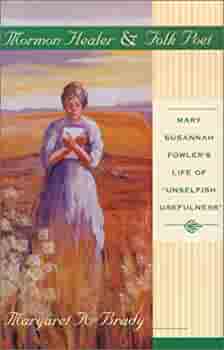Articles/Essays – Volume 35, No. 4
A Patchwork Biography | Margaret K. Brady, Mormon Healer and Folk Poet: Mary Susannah Fowler’s Life of “Unselfish Usefulness”
“. . .I cut out my patch work & you rested from shoveling snow.” (105)
In pioneer times, women salvaged and collected whatever scraps of fabric they could find and created quilts that were often colorful, dynamic, and artistic. In a similar manner, Margaret K. Brady has pieced together a biography of Mary Susannah Sumner Fackrell Fowler, a Mormon woman who lived in Utah from 1862 to 1920. She gathered information, including photographs, journals, oral narratives, records from various organizations, a grandson’s biography, and Mary Fowler’s own diary, poetry, and es says. Having skillfully arranged and manipulated her materials, Brady con structs the story of a polygamous wife and mother who was active as a nurse, midwife, healer, and poet.
In the introduction, Brady defines herself as a “folklorist by training, cultural historian by interest, and literary cultural critic by academic affiliation” (3). Her approach to the writing of the text is interdisciplinary, and she is particularly interested in “reflexive” or “reciprocal” ethnography (4). In this method, the researcher’s own role in the writing of the book becomes more visible and intertwined with the final product. She acknowledges that she is constructing her own version of the life of Mary Fowler, based on her particular interests and interpretations. However, she also places responsibility on the reader to become engaged with the text and to join her in con structing a personal perception of the Mormon healer and folk poet.
In the first chapter, Brady, a non-Mormon, explains that she stumbled across a reference to the manuscript diary of Mary Susannah Fowler in the card catalogue at the University of Utah Marriott Library while seeking an idea for a talk for a folklore conference. She read the diary and became so impressed and infatuated with the Mormon woman that she conducted extensive research on her life and eventually wrote this book. In Chapter 1 Brady also includes a short chrono logical summary of Mary’s life. The second chapter presents the concept of Mormon community, focusing not only on Mary’s own life, but also on her relationships with other women in Orderville, a town which followed the United Order. In the third chapter, Brady details Mary’s activities as a midwife and healer and discusses the metaphor of the “nurturing mother” (83). Chapter 4 deals with the concept of literacy within the community, and Chapter 5 discusses and analyzes Mary’s folk poetry. The final chapter reflects on the various discourses utilized in the former chapters and on life writing as a genre.
Born in Woods Cross, Utah, Mary was one of fifteen children (only eight survived to adulthood) born to David Bancroft Fackrell and Susannah Sumner Fackrell. The family eventually moved to Mt. Carmel, where Mary was baptized, and then relocated once again two miles north in Long Valley. They eventually settled in what became known as Orderville, where Mary met and married Henry Ammon Fowler. While here, Mary gave birth to her first five children, and her husband took a second wife, Eliza Norwood. In 1888, Henry moved both families to Huntington, where Mary experienced seven more pregnancies, from which only three children survived. In 1903, at her request, Henry moved Mary and her children to Provo, so two of their sons could attend Brigham Young Academy, and while there she took some courses to add to her knowledge of nursing. After about four years, the family returned to Huntington and then moved to Price a few years later. In 1920, Mary died shortly after surgery in Salt Lake City, where she had gone for specialized medical treatment.
This biography, which has been meticulously pieced together, is worth reading. It is apparent that Brady is passionate about her subject, and she is respectful of Mormon doctrine and beliefs. Eighteen photographs and il lustrations enhance the text and provide further documentation for the book. However, as a Mormon reader, I expected more emphasis on the hardships and trials of this woman who lived in polygamy and poverty during difficult times. It seems that Brady anticipated this criticism. In response to her portrayal of the relationship of Mary and her “sister-wife” Eliza, she writes, “It might appear from this discussion that I have idealized the nature of that relationship” but “Mary’s own writing virtually never indicates… animosity towards Eliza” (49, 50-51).
It is not until Chapter 5, which deals with Mary’s poetry, that there is more focus on tribulation and pain. In her poetry, Mary states that “life is hard, and trials cloud the way” and mentions “sacrifices suffered” and “our pains and our heartaches” (137, 148, 149). Also, in the last chapter, a long passage written by Mary about the family’s move from Orderville to Huntington refers to many difficulties, such as: “aching heart,” “rained very hard,” “very tired,” “tongue of his wagon broken,” “very cold day,” “snowed on us during the night,” “oh such mud!” “awfully tired,” “sharp wind blowing,” “rough roads,” “a stormy day,” “so tedious a trip” (176- 80). In her analysis of the poems and the description of the move, Brady ac knowledges the trials and sorrows. Mary’s own writing, however, satisfies my desire to learn of her tribulations more than does Brady’s interpretation of that writing. Yet, in a way, my response shows that Brady is successful in bringing about the collaboration she wants to occur between author and reader. She provides a perspective which has not been framed by an LDS upbringing, and I, a descendant of Mormon pioneers and polygamists, fulfill my responsibility to remember the pain, suffering, and sacrifice of those who preceded me.
Mormon Healer and Folk Poet: Mary Susannah Fowler’s Life of “Unselfish Usefulness,” by Margaret K. Brady (Logan, Utah: Utah State University Press, 2000), 222 pp.


 Back to full Issue
Back to full Issue

